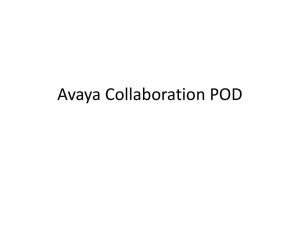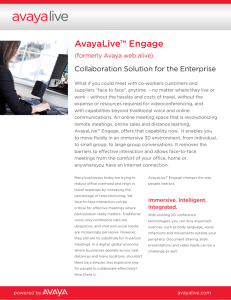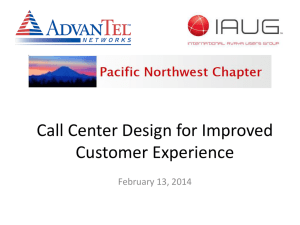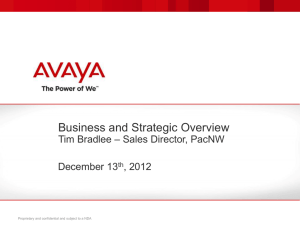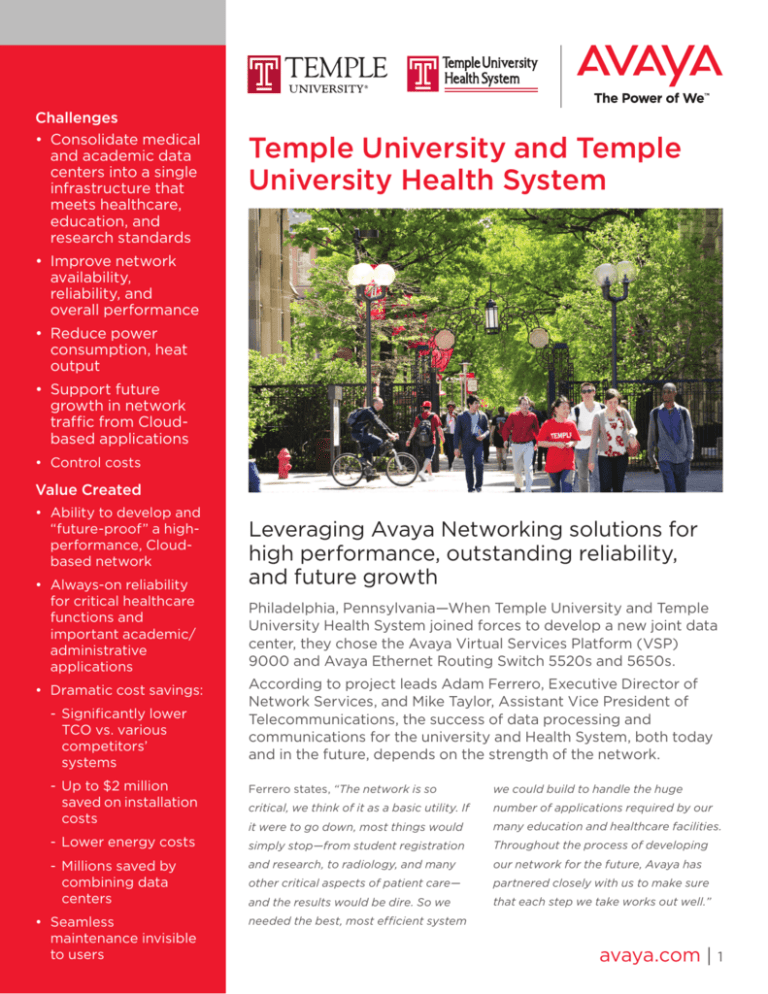
Challenges
• Consolidate medical
and academic data
centers into a single
infrastructure that
meets healthcare,
education, and
research standards
Temple University and Temple
University Health System
• Improve network
availability,
reliability, and
overall performance
• Reduce power
consumption, heat
output
• Support future
growth in network
traffic from Cloudbased applications
• Control costs
Value Created
• Ability to develop and
“future-proof” a highperformance, Cloudbased network
• Always-on reliability
for critical healthcare
functions and
important academic/
administrative
applications
• Dramatic cost savings:
- Significantly lower TCO vs. various competitors’ systems
Leveraging Avaya Networking solutions for
high performance, outstanding reliability,
and future growth
Philadelphia, Pennsylvania—When Temple University and Temple
University Health System joined forces to develop a new joint data
center, they chose the Avaya Virtual Services Platform (VSP)
9000 and Avaya Ethernet Routing Switch 5520s and 5650s.
According to project leads Adam Ferrero, Executive Director of
Network Services, and Mike Taylor, Assistant Vice President of
Telecommunications, the success of data processing and
communications for the university and Health System, both today
and in the future, depends on the strength of the network.
- Up to $2 million saved on installation costs
Ferrero states, “The network is so
we could build to handle the huge
critical, we think of it as a basic utility. If
number of applications required by our
it were to go down, most things would
many education and healthcare facilities.
- Lower energy costs
simply stop—from student registration
Throughout the process of developing
- Millions saved by combining data centers
and research, to radiology, and many
our network for the future, Avaya has
other critical aspects of patient care—
partnered closely with us to make sure
and the results would be dire. So we
that each step we take works out well.”
• Seamless
maintenance invisible
to users
needed the best, most efficient system
avaya.com | 1
“Avaya VSP 9000s in our
core give us 10 to 20 times
The transformational choices that
several vendors. Key considerations
Temple University and Temple
of reliability, performance, and cost
University Health System have made
ultimately led them to Avaya. They
the capacity of our older
over the past few years began when
decided to purchase the Avaya VSP
environment. The price-
the aging building that housed the
9000 for the core of their network
Health System’s data center was
and Avaya Ethernet Routing Switch
scheduled for demolition. The
5520s for the edge.
and-performance profile of
the Avaya Switches was
university decided to contract with an
clearly superior to
engineering firm that specializes in
anything we saw among
data centers. The firm was tasked
with designing a high-performance
the competition. Overall,
data center to meet extremely
the total cost of ownership
demanding healthcare, education,
proposition from Avaya
was very powerful.”
“We’ve not seen anything in
and research requirements on
bandwidth, network availability,
cooling, and power usage. It became
clear to the IT teams for both
Taylor comments, “Avaya VSP 9000s
in our core give us 10 to 20 times the
capacity of our older environment.
The price-and-performance profile of
the Avaya Switches was clearly
superior to anything we saw among
the competition. Overall, the total cost
of ownership proposition from Avaya
was very powerful.”
organizations that co-locating and
At the edge of the network, the
terms of bandwidth from
sharing one combined data center
Temple IT team set out an ambitious
the student lab and from
would result in cost savings for the
plan to swap in over 2,000 Ethernet
healthcare organization and access to
Routing Switch 5520s across the
a world-class data center and
campus. These Avaya Switches
haven’t been able to
network for the university.
support convenient and cost-effective
handle. Our Avaya network
The project team was looking to
is extremely resilient and
handle not only the current
new medical apps that we
flexible. I think we’re on the
bandwidth load at higher levels of
reliability and lower power usage, but
Power-over-Ethernet (PoE)
technology that eliminates separate
AC power supplies for any PoE
devices connecting to the network.
leading edge of what a
also to take on future bandwidth
“In the plans for our new
data center and a server
requirements. “Our focus was on
12,000-square-foot center, we worked
maximizing uptime, minimizing
out two completely separate power
downtime; in short, achieving an
buses feeding each cabinet in the
extremely high level of reliability,”
room,” Taylor explains. “To keep the
Taylor explains. “This is necessary
Switches cool, we have quite an
because the number of applications
impressive chilled water plant. It was
that we are asked to support on both
also important to find Ethernet
the healthcare side and the academic
Switches that could produce less heat
side continually grows, and we have to
and consume less power. Driving all of
be ready and agile to support that
this was the fact that we needed an
growth.”
improved Switching core that could
environment should be.
And we’re definitely
supporting the growing
trend toward Cloud-based
applications.”
— Mike Taylor,
Assistant Vice President of
Telecommunications
support our 10 Gbps uplinks.”
“Clearly superior”
pricing and
performance
2
| avaya.com
The flexible Avaya architecture made
it possible for the Temple IT team to
make a major cost-saving plan
In deciding on the switching
modification midstream—changing to
infrastructure, Taylor, Ferrero, and
an all-fiber distribution. “Being able to
their teams reviewed proposals from
make this decision well into the
project was a major advantage for us.
network. Temple’s VSP 9000s are
network. It recently built a student
We estimate that it saved us about
connected by multilink trunks so that
technology center—one of the largest
$1 1/2 to $2 million in installation
if either one in the Cluster fails, the
in the United States—with 700
costs,” Taylor comments.
other will take over and handle the full
computers that are based on a Cloud
load.
model, which puts ever-increasing
Reliable and
cost-effective
high-performance
Switching
Moreover, the Avaya VSP 9000 is also
demands on the network.
resilient when it comes time for
“We’ve not seen anything in terms of
routine maintenance. “We can make
bandwidth from the student lab and
in-service updates to our VSP 9000s
from new medical apps that we
Consolidating the medical and
without affecting applications,”
haven’t been able to handle,” Taylor
academic computing in a single data
observes Ferrero. “It’s all pretty
emphasizes. “Our Avaya network is
center gave Temple a unique
seamless, and our users are
extremely resilient and flexible.
opportunity to save on infrastructure
completely unaware. The bottom line
I think we’re on the leading edge of
costs.
is that our uptime and reliability
what a data center and a server
numbers are now higher.”
environment should be. And we’re
Taylor explains, “Not having to
definitely supporting the growing
support two data centers reduced
In summing up the Avaya Switches,
both up-front costs and ongoing
Timothy O’Rourke, Temple University
maintenance. We are able to save a lot
Chief Information Officer (CIO), notes:
of money by depending on the VSP
“We have redundant Avaya VSP
9000 to have the Switching capacity
9000s that actively work together. If
to handle all the traffic hitting our
one goes down, the other one can
the VSP, no matter what we
network, which is really central to the
carry the full load without any impact
design of our data center.”
to our users. We can take a whole
‘threw’ at it, we could not
In its initial testing of the powerful
VSP 9000s, the Temple IT team tried
to ‘break’ the 9000s by flooding them
with packets, but without success.
Ferrero reports, “In testing the
resiliency of the VSP, no matter what
we ‘threw’ at it, we could not slow the
CPU on the chassis. The management
function, the base function of the VSP
9000 chassis, is protected in
support up to 27 terabits per second
of total traffic with its unique Network
Processing Unit technology. In the
Avaya approach, large-scale CPU
arrays efficiently examine and
manipulate packet headers at 10 Gbps
line rates.
applications.”
“In testing the resiliency of
series of these core Switches down,
slow the CPU on the
run updates on them, and reboot
chassis. The management
them. This allows us to upgrade
function, the base function
without having to bring the network
down. Without this redundancy, trying
of the VSP 9000 chassis, is
to update a busy university network
protected in hardware.
such as Temple’s—serving 39,000
That’s outstanding!”
students and four affiliated hospitals—
is like trying to perform a heart
transplant on someone who is running
a marathon.”
hardware. That’s outstanding!”
The Avaya VSP 9000 is architected to
trend towards Cloud-based
“We can make in-service
updates to our VSP 9000s
without affecting
Energy-efficient,
future-proof network
with outstanding
Avaya support
With the Avaya core in place, the
applications. It’s all pretty
seamless, and our users are
completely unaware. The
bottom line is that our
Temple IT team was confident that it
uptime and reliability
had a network switching capacity to
numbers are now higher.”
accommodate any new applications
Temple also takes advantage of
going forward. Temple University is
Avaya’s pioneering Switch Clustering
using “thinner,” Web-based software
technology to enable an always-on
that is entirely dependent on the
— Adam Ferrero,
Executive Director of Network Services
avaya.com | 3
Along with reliability, energy efficiency has become an important consideration for
data centers, especially with the current focus on greener computing. “When we
“We have redundant
Avaya VSP 9000s
that actively work
together. If one
were going through the bid process, power efficiency and energy savings were very
critical,” Taylor recalls. “We’re trying to be as green as we can, and with the Avaya
Switches we calculated substantial savings compared to other vendors.”
The Temple IT team plans to continue to leverage the relationship with Avaya, and
especially the outstanding support it’s received from the VSP team. “Avaya’s VSP
goes down, the
engineers have the right can-do approach. The firmware upgrades we received from
other one can carry
them have been incredibly easy to install and have made the product better and
the full load without
any impact to our
better,” Ferrero says. “Beyond that, as customers, we feel that Avaya just always
does the right thing by us, and that type of relationship is important to achieving
our goals.”
users. We can take
a whole series of
these core Switches
down, run updates
Learn More
For more information, contact your Avaya Account Manager or a member of the
Avaya Connect channel partner program, or access other collaterals by clicking on
Resource Library at www.avaya.com.
on them, and
reboot them. This
Statements in this case study were made by Mike Taylor, Assistant Vice President of Telecommunications;
Adam Ferrero, Executive Director of Network Services; and Timothy O’Rourke, Chief Information Officer.
allows us to
upgrade without
having to bring the
network down.”
— Timothy O’Rourke,
Chief Information Officer
Systems and Applications
• Avaya Virtual Services Platform 9000
• Avaya Ethernet Routing Switch 5520
ABOUT TEMPLE UNIVERSITY
About Avaya
Founded in 1884 by Dr. Russell Conwell, Temple College became Temple University
Avaya is a global
provider of business
collaboration and
communications
solutions, providing
unified communications,
contact centers,
networking and related
services to companies
of all sizes around
the world. For more
information please visit
www.avaya.com.
in 1907 and has evolved into a comprehensive urban research and academic
4
| avaya.com
institution. The University’s 39,000 students can choose from 9 campuses and 333
academic degree programs. For more information, please visit www.temple.edu.
ABOUT TEMPLE UNIVERSITY HEALTH SYSTEM
Temple University Health System consists of Temple University Hospital (TUH);
TUH-Episcopal Campus; TUH-Northeastern Campus; Fox Chase Cancer Center;
Jeanes Hospital; Temple Transport Team; and Temple Physicians, Inc., a network of
community-based specialty and primary-care physician practices. For more
information, please visit www.templehealth.org.
© 2012 Avaya Inc. All Rights Reserved.
All trademarks identified by ®, ™, or SM are registered marks, trademarks, and service marks, respectively, of Avaya Inc.
11/12 • DN7153


